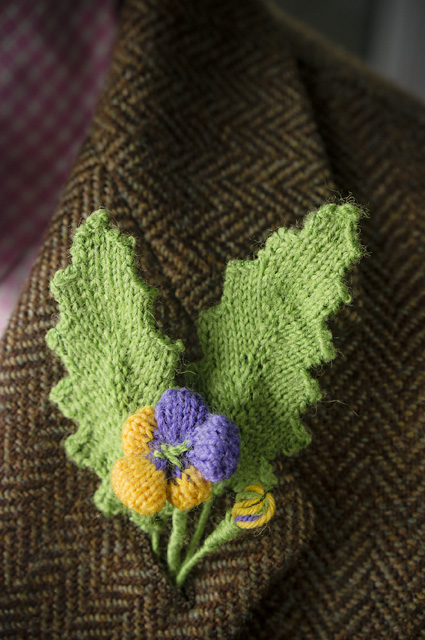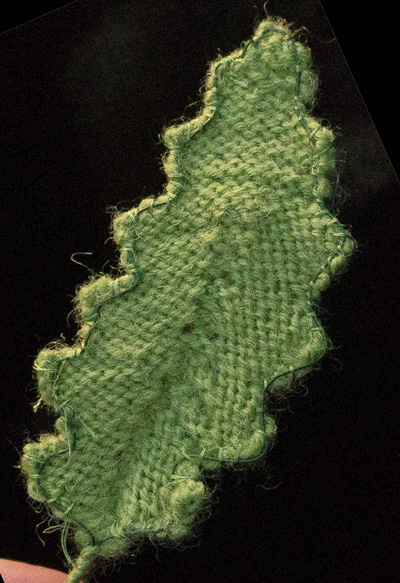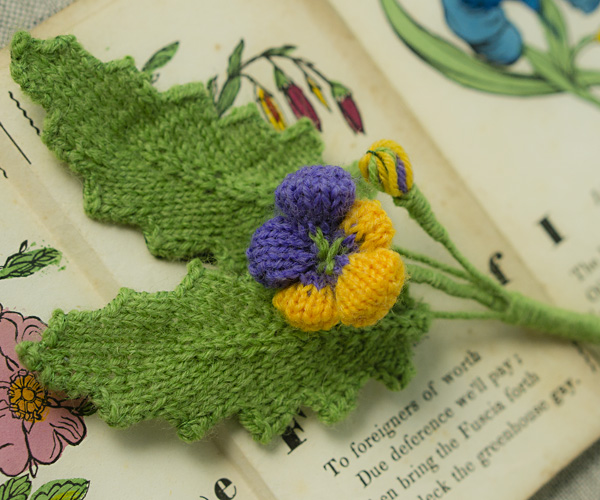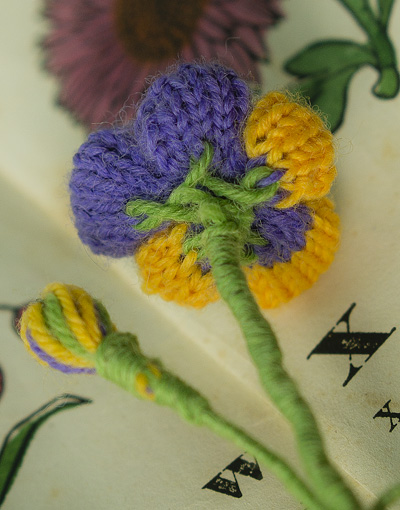

|
| by Franklin Habit | |
|
|
|
A romantic temperament is the enemy of good history writing. As I am cursed with the former, I struggle with the latter. The duty of the historian is to uncover and present facts. He or she will necessarily select them, edit them, arrange them, interpret them -- but ought not to embellish or invent them. But here's the thing: Good history doesn't necessarily guarantee a good story. Have you seen that amazing HBO mini-series about the War of 1812? No, you haven't. The War of 1812 was a pivotal event in the history of the fledgling United States. But narratively? A snoozefest.* When the subject is the history of knitting, the temptation to embellish is ferocious. In part it's because there's not much to work with. When it comes to knitting, the written record is nearly mum for centuries at a time, as is the visual record. Extant examples?** Few and far between, especially prior to the nineteenth century. With little or nothing to analyze, there is little or nothing to say -- unless you choose to invent. So knitting history attracts invention the way knitting itself attracts curious cats, spilled coffee, and Velcro. Many of the most commonly traded stories are suppositions (or pure fabrications) that have gained an air of credibility through repetition. If you want to make a knitting historian cry,*** say any of the following:
(No it wasn't. No they weren't. No it wasn't. No you didn't.) Those are all very pretty stories. That's why it's fun to tell them. But when subjected to scrutiny (and they have been) there's either evidence proving they are untrue; or there's not enough evidence to support their claim to truth. You cannot call it history if you haven't got supporting evidence. Wishing will not make it so. Working on this issue's project, the clash between my desire to present you with good history and my desire to tell you a ripping tale was so extreme it caused a thunderstorm in my brain. I started calmly enough. I've had my eye on The Floral Knitting Book (1847) for years, ever since the University of Southampton graciously put online the collection of the late Richard Rutt (author of A History of Hand Knitting). It's a curiosity, certainly not of general interest. Making flowers out of things that were emphatically not flowers (wax, sugar, glass, silk, ribbons, tissue paper, human hair -- to name a few) was a Victorian mania. The book's introduction notes with apparent surprise that no other published work had yet addressed the creation of realistic flowers through knitting, then plunges into the recipe for a white lily. I almost gave up at the testing stage. Floral Knitting is a mess, frankly. The flowers themselves are remarkable for their commitment to realistic detail and ingenious construction. But to gather the information you may require for any one project about needles, gauge, materials, and techniques you have to read the whole thing, cover to cover, line by line. Even then, much is left out. Numbers, more often than not, fail to add up. I've written before about throwing misbegotten patterns at the wall. Floral Knitting came close to being set on fire. The more I started to think of the author as an adversary the more I began to wonder what sort of person she had been. The book says almost nothing. I don't even know her name. On the cover and title page, she is "A Lady." The Lady describes herself as "the Inventress" on a page offering private lessons, then -- tantalizingly -- gives her four initials and an address in the neighborhood of Somers Town, London. A little digging turned up some intriguing information. The address no longer exists, having been razed and replaced in the twentieth century by a public housing estate. At the time the book was written, the neighborhood was...well, not "bad," perhaps, but not what the English would call "smart." Most certainly not fashionable. So here was this Lady, living in a shifty part of London and inviting women of leisure to come to her home to learn floral knitting. My romantic temperament threatened to run off at full gallop. It wanted me to present you with a pathetic, hand-tinted tale of a genteel Early Victorian lady desperately seeking to stave off poverty without losing her respectability. Alone and afraid, with the wolf (and the bailiffs) at the door, she scrambled together her last pennies to publish the book and establish a teaching clientele. All of which, of course, is speculation. Fiction. It's not history. I still don't know anything about the woman in question but her initials, her publisher, and her address. I can't write about the rest in a history column. But it turns out I can't stop thinking about her. So I'm going hunting. I'll let you know what I find. Stay tuned. Notes on the patternFloral Knitting's garden of delights includes a dozen varieties, from the modest Michaelmas Daisy (Aster amellus) and the tiny Snow Drop (Galanthus nivalis) to the va-va-voom Crown Imperial (Fritillaria imperialis). What the Lady intended should be done with the finished flowers is mostly left to the imagination. I'm betting more than a few arrangements wound up on parlor tables under glass domes. My apartment is bit old-maidish, but that's going too far. She does suggest a few varieties be can used as dress or hat ornaments, and that's when it hit me: a boutonnière. Aside from weddings and funerals they've been out of fashion for a good century or so, but I never let that stop me from wearing anything. I love them, I wear them, and I wanted a knitted one. Then I remembered that the common American name for Heart's-Ease (Viola tricolor) is Wild Pansy. *Although it has at least one potentially boffo female role: Dolley Madison, whom I'd like to see played by Jennifer Ehle. **That's an actual piece of knitting -- whole or fragment -- that has survived to the present day. ***Or punch you.
|
|
| |
|
 by Franklin Habit, translated from The Floral Knitting Book; or, The Art of Knitting Imitations of Natural Flowers |
|
|
|
|
| SIZE |
One |
|
FINISHED MEASUREMENTS |
| Leaf: 6 inches from stem end to tip of leaf. Flower: Approximately 1 inch x 1 inch |
|
MATERIALS |
GAUGE PATTERN NOTES Make 1: Increase by casting on 1 st using the backward loop method described here. When you encounter this new st on the next row, knit it through the back. Herringbone Stitch: This is not the knitted herringbone, but the hand-sewing stitch as described here.
|
|
DIRECTIONS |
 Using long-tail method, and C1, CO 3 sts, leaving 10-inch tail. Work all rows of Leaf Chart. BO. Weave in ends. With wire snips, cut a length of florist wire about 20 inches long. Secure the thread near the base of the leaf with a few whip stitches. Leaving a wire "stem" approximately 5 inches long below the base, whip stitch the florist wire around WS edge of the leaf. Bend the wire as you proceed to conform to the contours of the edge. Upon reaching base again, knot thread securely to leaf and snip thread ends close. You should have an additional 4-5 inches of florist wire remaining. Twist these wire "stems" together tightly, using pliers if necessary. Wrap the CO tail tightly around the stem from the leaf to near the cut end, taking care the wires are completely covered. Secure with an overhand knot. Bend the wire end upwards to hold the knot in place. Trim off the excess yarn and wire ends. FLOWER
Turn work. Row 1: [K1, sl 1 purlwise] across. Turn work.
Weave in tail and cut off excess. Twist the ends of the wire together tightly below the base of the petal, and trim to a length of about five inches. Set aside. 
Using C3, CO 8 sts. Work in double-knitting as for Purple Petal. Work in C3 for 4 rows; then join C2 and work for 2 rows. Finish as Purple Petal, weaving loose in ends before turning petal inside-out. LARGE YELLOW PETAL Using C3, CO 12 sts. Work as for Purple Petal in C3 for 6 rows; then join C2 and work for 3 rows. Finish as Purple Petal, weaving loose in ends before turning petal inside-out. Work in double-knitting as for Purple Petal.  Bring all petals together as shown in the photographs: the two purple at the top, the large yellow at the bottom, flanked by the two small yellow. Twist the wires of all the petals together firmly; this will likely require use of the pliers. FLOWER CENTER AND CALYX Using photograph at right as a guide, form the calyx by making one long, loose herringbone st into the back of every petal. Tie the two ends of the sewing yarn together with two knots at the base of the flower. Flower Stem. BUD
Clip one tail of the knot short. Use the other tail to wrap the stem of the bud as the stem of the leaf. FINISHING |
||||||||||||||||||||||||||||
| ABOUT THE DESIGNER |
 After a boyhood of being forced into navy blue and mud brown sacks, he enthusiastically welcomes the return of men's fashions that are wholly unsuited to duck hunting, touch football, or tractor pulls. |
| Pattern & images © 2014. Franklin Habit. |